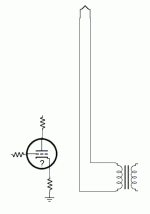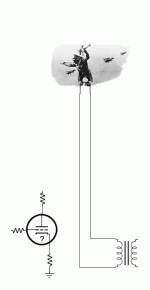Hello!
I just changed chassis for my simple 5687 preamp to an amazing new box, The future plan is to put in a phono stage, so there was a transition to DC heaters. With the transition to DC the heaters need to be elevated even higher to get rid of noise ( there is still a little bit in there, possibly from the shift from 6.3v to 12.6v heaters). The heater supply is Regulated, ripple less than 1mv (scope confirmed).
My question to the DIY community is how high can I elevate the heaters? I want to raise them to something like 90-95v above ground, this would put the heaters way above the noise floor. are there any consiquences I should consider?
Thanks a bunch.
-Moose
I just changed chassis for my simple 5687 preamp to an amazing new box, The future plan is to put in a phono stage, so there was a transition to DC heaters. With the transition to DC the heaters need to be elevated even higher to get rid of noise ( there is still a little bit in there, possibly from the shift from 6.3v to 12.6v heaters). The heater supply is Regulated, ripple less than 1mv (scope confirmed).
My question to the DIY community is how high can I elevate the heaters? I want to raise them to something like 90-95v above ground, this would put the heaters way above the noise floor. are there any consiquences I should consider?
Thanks a bunch.
-Moose
Stay within the heater-cathode voltage ratings from the spec sheet. If your heater supply is DC it shouldn't be contributing any hum though. In any case, a Tung-Sol paper from the Thirties had a graph showing about 35 volts positive between heater and cathode pretty much reached maximum benefit. I aim for 30-40 volts above maximum positive cathode AC signal voltage within the limits of the tube ratings.
Before the heaters were rased at all, it was pretty horrible, volume controll did nothing to it, I raised the Heaters to ~35v and the hum was gone when the pot was bast 3 O'clock, it wasn't very loud at all, but I have fixed the exact same problem elevating the heaters before hand as well. At ~75 Volts it sounds stunning My SACD of Layla really likes it
Moose, did you change the filter cap in the heater bias supply when you raised the voltage? If so you may be hearing the effect of changing this cap as well as the change in voltage. I have found that this filter cap has a definite effect on sound quality. Try different types without changing the voltage and you hear the effects of the cap alone.
Salectric said:I have found that this filter cap has a definite effect on sound quality.
What kind do you like there?
Dave
Heater Elevation, how high?
About this high:
Attachments
Dave,
My favorite cap for the heater bias supply is an old Fiable plastic cap. I'm not sure if it was polypropylene or polystyrene. It has a rectangular yellow body and is rated at 160V. I bought a number of them from Old Colony Sound Lab back in the 1970's and have been gradually using them up. The value doesn't seem particularly important sonically. I've used .15uf and 1.0uf and couldn't tell any difference. It's nothing exotic but it has a smooth inoffensive sound quality that's easy to ignore.
I have also used a large Panasonic TSHA cap (100uf or so) with good results. I didn't compare the TSHA to the Fiable so can't really comment on what differences there would be between the two. The TSHA was far better sonically than a Nichicon MUSE however.
Some other caps that I tried and did not like in my particular applications (phono and line stages) were: InfiniCaps, MIT/RelCaps, Jensen PIO with copper foil, oil caps from Cary, Solens, Nichicon electrolytics, etc.
I have read of other people noticing that noise levels decreased with higher value caps. For whatever reason, I have never had noise problems, at least where the heater bias supply cap made any difference. The value of the cap just doesn't seem to correlate to any sonic changes. I've tried caps ranging from .1uf to 100uf and what I heard each time was the sound of the type of cap, not anything relating to its value.
BTW I noticed the same sonic issues with the bias cap whether the heater supply is DC or AC.
My favorite cap for the heater bias supply is an old Fiable plastic cap. I'm not sure if it was polypropylene or polystyrene. It has a rectangular yellow body and is rated at 160V. I bought a number of them from Old Colony Sound Lab back in the 1970's and have been gradually using them up. The value doesn't seem particularly important sonically. I've used .15uf and 1.0uf and couldn't tell any difference. It's nothing exotic but it has a smooth inoffensive sound quality that's easy to ignore.
I have also used a large Panasonic TSHA cap (100uf or so) with good results. I didn't compare the TSHA to the Fiable so can't really comment on what differences there would be between the two. The TSHA was far better sonically than a Nichicon MUSE however.
Some other caps that I tried and did not like in my particular applications (phono and line stages) were: InfiniCaps, MIT/RelCaps, Jensen PIO with copper foil, oil caps from Cary, Solens, Nichicon electrolytics, etc.
I have read of other people noticing that noise levels decreased with higher value caps. For whatever reason, I have never had noise problems, at least where the heater bias supply cap made any difference. The value of the cap just doesn't seem to correlate to any sonic changes. I've tried caps ranging from .1uf to 100uf and what I heard each time was the sound of the type of cap, not anything relating to its value.
BTW I noticed the same sonic issues with the bias cap whether the heater supply is DC or AC.
rdf said:Had to be done.
For such elevation air gap capacitors are needed...
alexmoose said:I had never heard of this. I have an Electrolitic cap in there that was free out of a computer power supply. like 200uf at 250v. assuming I replace this with a Solen Cap (the likely replacement) what size should I pick??? are there any general rules?
if routing is clean and resistive divider for elevating is reasonably sized ( current around or just under 1mA) ,1uF will suffice
- Status
- This old topic is closed. If you want to reopen this topic, contact a moderator using the "Report Post" button.
- Home
- Amplifiers
- Tubes / Valves
- Heater Elevation, how high?

